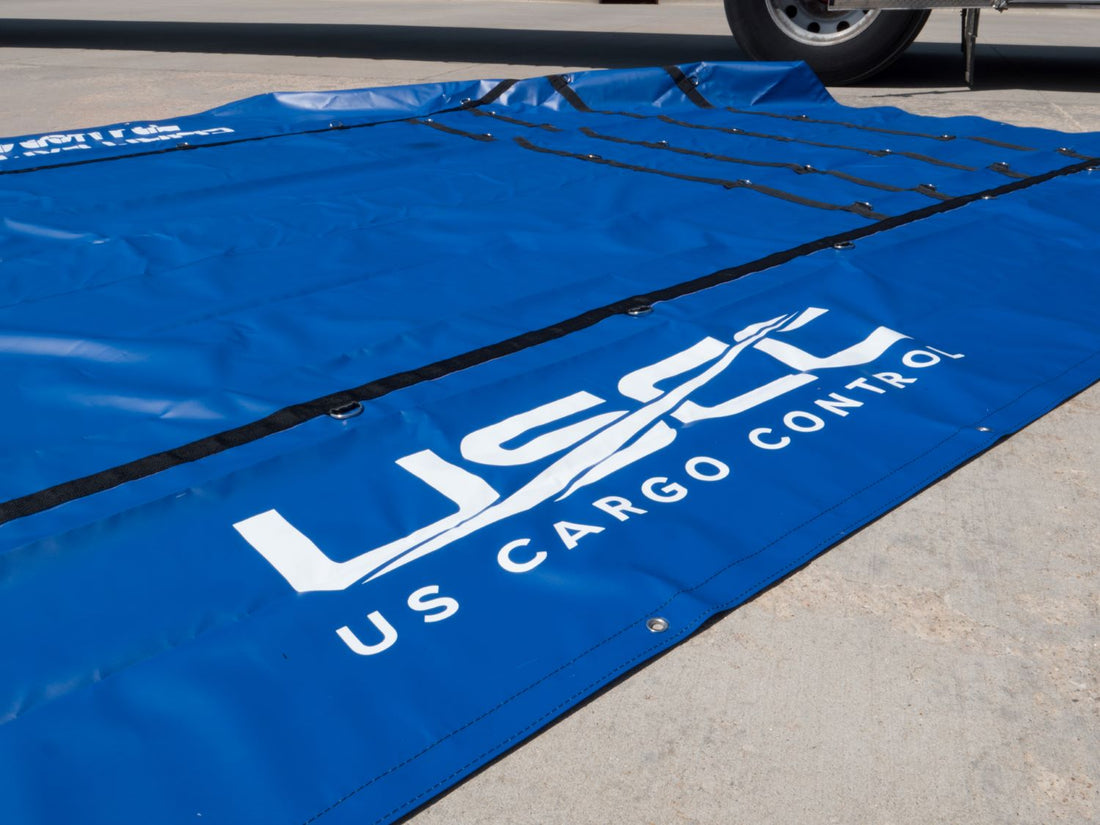
How to Repair a Truck Trailer Tarp in 5 Steps (with Repair Kit)
Flatbed trailer tarps are great for protecting your cargo from the elements during transportation. However, wear and tear over time leads to holes, tears, fraying and other damage that can compromise the tarp's effectiveness.
Luckily, repairing a damaged truck tarp is a relatively straightforward process that anyone can do. With the right tools, such as a tarp repair kit, truckers can make emergency repairs as needed and extend the life of their tarps for successful deliveries.
Read below to learn more about how to repair a truck trailer tarp in 5 simple steps.
5 Steps for Repairing a Truck Trailer Tarp

1. Assess the Damage
The first step in repairing your truck tarp is to thoroughly assess the damage sustained. Take a close look at the tarp and identify any tears, holes, or areas of weakness. This gives you a clear understanding of the extent of the damage before you start your repairs.
Based on the amount of damage, you may want to consider a few methods of repair:
-
Tarp Tape: Use this option for temporary fixes. If you're on the road and need a quick patch, tarp tape works great to shore up any tears. However, it doesn't last long against the elements (i.e. sun, moisture, road debris, temperatures) and will deteriorate more if further repair to the tarp isn't done.
-
Tarp Repair Kits: The best option is to use a tarp repair kit. For medium-sized damage, repair kits come with the necessary elements to make repairs and maintain the tarp's integrity. These patches last for a long time and hold up against the elements similarly to the tarp's material.
- Replacement Tarp: Purchasing a replacement tarp should be the last option. If the damage is too significant to be mended by tarp tape or with a repair kit, then you might need to replace your old tarp with a new one. This is imperative for damage sustained beyond the material itself, such as the tarp straps and D-Rings.
Make sure to use the appropriate method based on your tarp's damage.
2. Buy a Tarp Repair Kit
As previously mentioned, tarp repair kits offer many benefits versus tarp tape or buying a replacement tarp, such as being:
- cost-effective,
- a quick and convenient solution,
- easy to use,
- customizable to the damaged area(s), and
- able to maintain the tarp's integrity.
General tarp repair kits typically include patches and some form of adhesive or stitching materials. Other materials needed include scissors or a utility knife to cut the tarp patch to size, a patch roller to smooth it out, and gloves to protect your hand from cuts or irritation from the adhesives.
US Cargo Control offers tarp repair kits that include 2' x 2' 18-oz. polyester tarp patches and 8-oz. cans of vinyl cement for sturdy adhesion. The HH-66 formulation of the vinyl cement offers excellent resistance to temperature and weather, and withstands water, oil, grease, fuel, and other chemicals from leaking through.
- Shop our selection of Polyester Tarp Material by the yard for additional coverage!


3. Prepare the Surface
Next, clean and prepare the damaged area of the tarp before applying the patch. Any dirt or debris around the damage will get trapped under the tarp patch, making it less effective at staying on the tarp. Whether you use an adhesive and/or stitch the patch on, this step makes the world of difference to your tarp repair process.
Lay your truck trailer tarp on a flat surface and use soap and water to scrub the area clean. For tougher stains caused by oil, use rubbing alcohol or a mild detergent to remove these spots. Make sure to clean plenty of space around the damaged area to prevent any debris from affecting the repair process. Let the area dry thoroughly before patching up the tarp.
4. Apply Tarp Patch
After the surface becomes clean and dry, then you are ready to repair the tarp. First, cut the tarp patch to the right size of the damaged spot using your scissors or utility knife. When cutting the patch, allot two inches beyond the damaged area for proper coverage. Place it over the damage to ensure it covers enough.
Use the vinyl cement to coat the back side of the patch and the damaged area. Apply plenty of the adhesive for a firm stick to the tarp. Once placed over the damaged spot, smooth the patch out using a roller or with your hands. This not only removes air bubbles or seams, but ensures a secure bond between the patch and the tarp itself.
If necessary, trim any excess patch material with scissors or a utility knife.
5. Allow Time to Cure
Lastly, allow sufficient time for the tarp patch to bond with the tarp. Depending on what type of patch and adhesive you use, the curing time ranges from a few hours to overnight. US Cargo Control's vinyl cement usually takes at least three hours to cure for tarp repairs.
Make sure you avoid exposing the repaired area to excessive moisture or stress during the time for a successful repair.
Helpful Tips on Repairing Truck Tarps
Repairing a damaged truck tarp with a tarp repair kit is a simple and cost-effective solution that can extend the life of your tarp and protect your cargo during transportation. Besides the five-step process explained above, there are a few other tips you should know before embarking on this process:
-
Reinforce High-Stress Areas: For areas of the tarp that are subject to frequent stress or tension, such as seams or corners, consider reinforcing the repair with additional patches or adhesive for added durability.
-
Repair Both Sides of Damaged Areas: With larger areas of damage or big holes, consider applying tarp patches on both sides of the tarp. This adds extra strength to the tarp and holds up longer. Do this by patching up one side first and apply another patch to the other side, allowing time in between for the first patch to set up.
-
Monitor Repaired Areas: After completing the repair, keep an eye on the repaired areas during use so that the patch remains securely in place. If you notice any signs of peeling or lifting, reapply the patch or reinforce as needed.
Know Your Truck Trailer Tarps
Not all trailer tarps are the same. Understanding the different types catered to specific trailers makes the world of difference (and can affect the longevity of your tarps). US Cargo Control offers a variety of truck trailer tarps to fit your specific needs, including:
We also offers 3-Piece Lumber Tarps that allows you to use each section individually while providing full coverage over the length of your flatbed trailer.
Not finding the right tarp for your trailer needs? US Cargo Control makes custom flatbed tarps made to the exact specifications you desire. Fill out our custom tarp form, and our team of experts will follow up on your request to verify everything before we make the tarp. No matter the size and specifications, our custom trailer tarps deliver outstanding performance and withstand rigorous conditions over a long time.
More Articles You May Like:
5 Pieces of Flatbed Trailer Equipment Every Driver Should Have
Flatbed Trailer Tarps: A Guide
How to Tie Down A Flatbed Trailer Tarp to Your Trailer
How Many Tie Down Straps Do I Need?
Parachute Material Tarps from US Cargo Control





